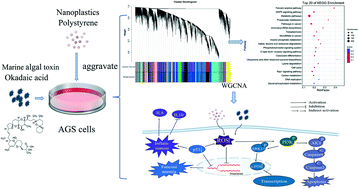Do polystyrene nanoplastics aggravate the toxicity of single contaminants (okadaic acid)? Using AGS cells as a biological model†
Abstract
The coexistence of nanoplastics (NPs) and various pollutants in the marine environment has become a problem that cannot be ignored. NPs and marine algae toxins are found in marine organisms and both can enter the human body through the food chain. However, the joint toxic effects of marine algae toxins and NPs on human health remain unknown. In this study, the joint toxic effects and mechanisms of polystyrene (PS) NPs and okadaic acid (OA) were investigated on human gastric adenocarcinoma (AGS) cells. AGS cells were exposed to 20 nm PS (0.5, 8 μg mL−1) or/and OA (5, 10 ng mL−1), and their cytotoxicity was assessed by measuring relevant indicators, transcriptomics, and weighted gene co-expression network analysis (WGCNA). Our data indicated that the joint toxicity of PS and OA to AGS cells was mainly characterized by a decrease in cell viability, depolarization of mitochondrial membrane potential, and a decrease in IL10 and p53 protein activity, accompanied by an increase in intracellular ROS production and calcium and IL8 levels in comparison with single contaminants. In addition, co-exposure to PS and OA caused cellular damage by activating PI3K/AKT, ERK/c-FOS and caspase-3/caspase-9 signaling pathways. Moreover, the high concentration of PS significantly enhanced the toxicity of OA. WGCNA highlighted enrichment in the Fanconi anemia pathway and MAPK signaling pathway and identified that IER3 was the hub gene in PS and OA co-exposed AGS cells. The results of this study provided insights into the joint toxicity evaluation of NPs and marine algae toxins.

- This article is part of the themed collection: Environmental Science: Nano Recent HOT Articles


 Please wait while we load your content...
Please wait while we load your content...